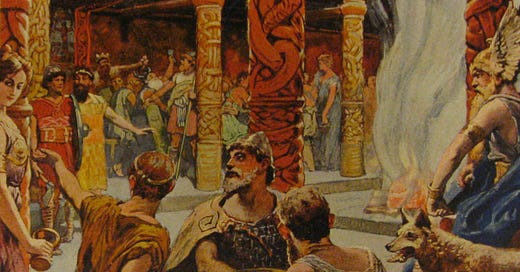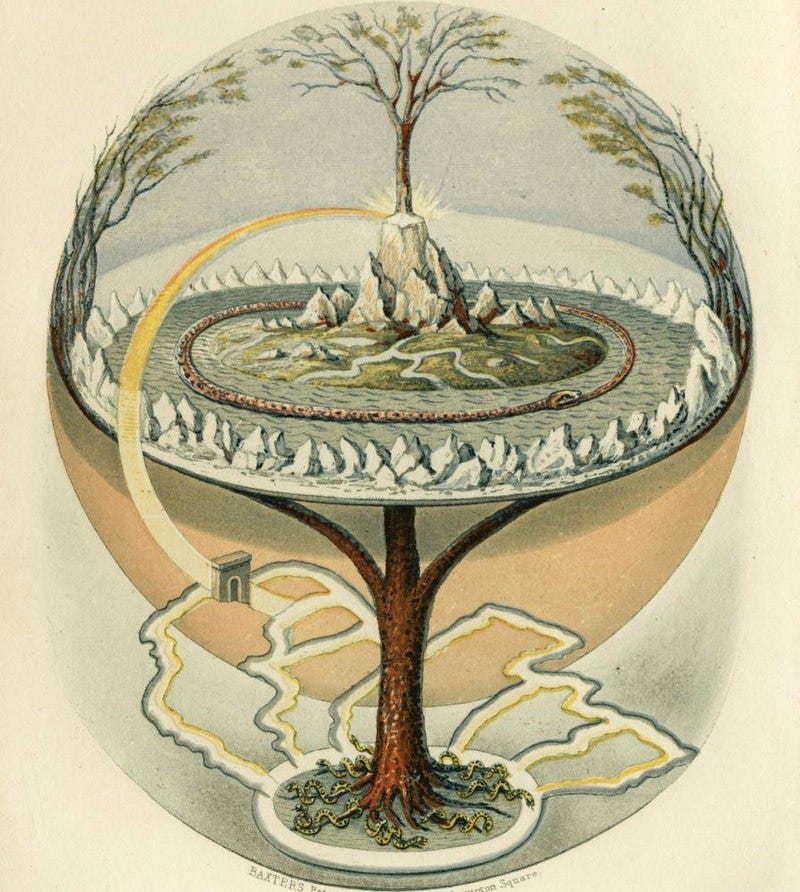In the Christian world, churches are miniature symbolic universes. The interior reflects a conceptual model with the four cardinal directions, the altar as Paradise, the middle as our earth and the west as darkness. Christianity emerged in the Roman world which already boasted sacred topographies and had to create its own. In Scandinavia, it also morphed into the Norse landscape with all its parishes and patron saints, which poses the necessary question: how was the Norse sacred world actually perceived? What did people actually think about their sacred places? We think we know a lot about Norse myth, when in fact we mostly resort to collections of poems and stories preserved in much later manuscripts and that only scratch the surface of the mental universe of Norse people.
Asgard in Norse myth
It's so tricky to draw a parallel here, because we are so used to centralized and coordinated state and religious structures that we neglect the more informal and flexible nature of the pre-Christian world. Perhaps we should be more tolerant of the possibility of different images of these worlds in people’s heads. The home of the gods, Asgard, has problems itself. The Icelandic scholar and chieftain Snorri provides the most detailed description in his Prose Edda (the fragment Gylfaginning) and in Ynglinga saga, but he was largely trying to build up a systematic Marvel universe, and neither his writings nor Marvel can be suspected of accurate representations of the past.
Anyway, Asgard figures as the residence of the Aesir, and it was built by a giant on Idavöll, whose horse ended up impregnating Loki with the spectacular result of Odin’s eight-legged horse Sleipnir. Gladsheim, the bright home, was Odin’s residence, probably including Hlidskjalf, the high seat from where he could overlook the entire world. In the famous Valhöll, covered with spears and shields, he would gather the greatest warriors in the desperate attempt to overcome fate at Ragnarök. Other gods would reside in golden Gladsheim too, besides that they also possessed a forge that provided them with the tools needed for further furnishings. They had the benefit of such skills in this golden age, before the arrival of the magical beings from Utgard (the outside world), like Gullveig who would cause the primordial war. Judging by its sensational hall, it is not hard to link Asgard to power and kingship.
Endless gold, craftsmanship, feasting, Odin’s all-seeing eye in the shape of the two ravens Hugin (Thought) and Munin (Memory or Mind). Even after losing some of its original splendour, Asgard would remain a place of intense imagination and longing. On the one hand, this conceptual framework of “Norse paradise” informed the construction of sacred places in Scandinavia, on the other hand, the very real halls of chieftains reinforced the metaphysical concept of the hall by means of the social exchange and religious performance happening inside.
Gudme on Funen
One such central place of performance that fits the idea of an axis mundi is Gudme on the island of Funen (Fyn) in Denmark. Gudme, quite literally the home of the gods, occupied a central position long before the Viking age. The settlement area is very extensive, its great hall impressive, and the amount of archaeological finds from the area, from coins to glass and bronzes, overwhelming. Because of the nature of the finds and its size, flanked by the Lundenborg port and Møllegårdsmarken cemetery, it could give us an idea of the shape and meaning of a central space in Norse culture. The settlement is about 4 km inland and lasted from about 200 to 600 AD, although the surrounding area had been inhabited earlier. Excavations revealed fenced farmsteads, about 50 in number, alongside three large houses including a 50m long hall with eight sets of huge posts to support the roof. A second floor is a distinct possibility. The three wide constructions were built with cogging techniques unusual for pre-Viking times.
The surroundings reveal enormous riches and trading connections. Hoards with Roman coins, scrap silver, gold pointing to forging and casting. Molten gold, silver, glass, strips of gold foil, jewellery including a Frankish bird fibula, bracteates, necklaces, either local production or from Byzantium. 4 kg of golden arm rings and bracteates were recovered from the nearby manor of Broholm. The local hoards also contain gold scabbard mouths, some with filigree, rings for sword pommels, perhaps symbols of the Frankish retinue. All in all, a huge area with treasures and a hall in the middle. The hustle and bustle of Lundeborg would have added to the brilliance of the place. While it is unclear what the area would have looked like in the migration period, in the 4th century objects like glass beads, terra sigillata, brooches, fittings for weapons as well as all kinds of smith tools suggest both commerce and local craftsmanship. The thousands of unused or broken iron rivets bear witness to the activity in the harbour.

In the cemetery, mostly cremation graves have been found up to the 5th century with lots of Roman objects (including a piece of a Hercules statue!) but no weapons. Like other cemeteries close by, traces of later burials are missing. However, it would have still been very visible in the landscape afterwards and left the impression of a place both very loaded spiritually and indicative of Germanic social practices like gift-giving. What speaks even more for the religious significance of Gudme are the place names in the surrounding area. The name Gudme itself suggests ancient worship, but in the vicinity three hills also carry sacred names: Gudbjerg (hill of the gods), Albjerg (hill with a shrine) and Galbjerg (hill of sacrifice or magic hill if we think of the Old Norse term galdr meaning chanted spells). In later sources we encounter Odin as the master of sorcery, but the galdrar, the chants, seem to have been perceived as particularly potent and dangerous since 8th-9th century Christian authors warned against these “barbaric” practices.
The names and archaeological record would suggest a central place of trade and production but also one of rituals and sacrifices. The recent discovery of a 5th century bracteate inscribed with Odin on the same island of Funen enforces the idea of the centrality of this particular god in the area, perhaps even as a marker of incipient kingship. Gold bracteates initially imitated Byzantine medallions but then motifs of Norse myth gained ground. So could we imagine a place like Gudme as a real life version of Asgard? The way the space is organized and the name would definitely suggest a magical doorway to the sacred. In the minds of the people of Gudme, the hall potentially dedicated to Odin would inspire the imagination of a greater hall in the supernatural realm, Asgard/Gladsheim. Consider the sheer size and grandeur of the place, 500m2, as well as its construction most likely by outsiders, resembling the mythological giants.
The high seat of Gudme’s hall would have held a similar symbolic power to that of Odin’s Hlidskjalf. Kingly and divine powers unified into an elevated place of wonder. Given that hof in Old Norse means both hall and temple, and godi both chieftain and ritual specialist, in this great building people would gather and share essential spiritual experiences like a sacrifice with splashes of blood on the walls, toasting to the gods and ancestors, even reciting mythological poems and bringing to life ancient gods and heroes in the guise of almost theatrical performances - we do have quite a lot of hints to acts performed in front of an audience, ranging from masked characters or gold foil figures to dramatic skaldic poetry and stage-like indications on later manuscripts. The tiny gold foil figures often depicting an embracing couple and discovered underneath the wooden posts also suggest a less practical and more ritualistic conception of these halls.
Lived spirituality is not quite retrievable from archaeology so we need to employ our imagination a little bit - chopping off some cattle, impaling their heads outside then indulging in the sweet mead of poetry? Hell yes, who said religion was boring? Afterwards we can move outside and have a go at metalworking. The placement of the workshops close to halls expressed the power of creation in this political and religious landscape. The excavations in Gudme also reveal dwellings of high-ranking warriors to the north, inescapably reminding us of Odin’s fellowship of the dead, the einherjar. We cannot be sure, of course, that the aristocratic elites of Gudme were dedicated to Odin, but it would fit the larger picture. There is one more area of mythical correspondence: the waters, more specifically the lake in the western part of the settlement, as well as the springs linking it to Gudbjerg and Galbjerg.
Could this be a reflection of the mythical springs rising from below the roots of Yggdrassil, near the wells of Urd and Mimir, the sources of fate and wisdom? Another spring passes the cemetery on its way to Lundeborg. Such a grand cemetery would be associated with the realm of Hel, situated by Snorri somewhere in the north, separated from the “middle enclosure”, mankind, by rivers. Very much like Hel, the cemetery lies between a centre, Gudme, and Utgard, the outside realm. We can also make a case for Lundeborg lying somewhere between the centre and the threatening world beyond, a transitional area between land and sea where goods, skills and crafts entered society, where shipbuilding and navigation opened new horizons. Even in our very profane universe, travelling still entails an aspect of initiation, and returning home in the safe space can be equally transformative. After trips into the unknown, entering Gudme and reaching the grand hall would feel a bit like leaving Utgard and joining the splendour of Asgard.
Even if some of these comparisons might sound a tad speculative, the evidence from Gudme does suggest a complex space with ritual and religious undertones, even the vast amounts of gold and treasure deposited remind of various later myths, like either carrying it in the afterlife or as a source for dwarves to transform it into sacred objects. Gudme invokes power, authority, richness, trade and spirituality all in one place, a realm of construction for Norse cosmology. Such sites, not only Gudme but also Uppåkra in Scania or Helgö in Mälaren in Sweden, are very likely to have been inspired by incipient ideas of godly realms like Asgard and in their turn inspire the later complex images of these realms. In the mind of people living here in the Iron age, they would have been perceived as central places in the larger cosmic world, comparable to the cathedrals and cloisters of the medieval Christian world.
References:
L. Hedeager, Iron Age Myth and Materiality: An Archaeology of Scandinavia AD 400-1000, Routledge, 2011
T. Douglas Price, Ancient Scandinavia: An Archaeological History from the First Humans to the Vikings, Oxford University Press, 2015
K. Randsborg, Beyond the Roman Empire: archaeological discoveries in Gudme on Funen, Denmark, in Oxford Journal of Archaeology, May 2007, pp. 355-366
P. Østergaard Sørensen, Gudme: Iron Age Settlement and Central Halls (Pre-Christian Cult Sites), Oxbow Books, 2022








I'm still laughing at Snorri trying to build the Marvel universe.
Extremely interesting. I wish I could go to Fyn and have a look around. I expect it’s a bit of a journey.